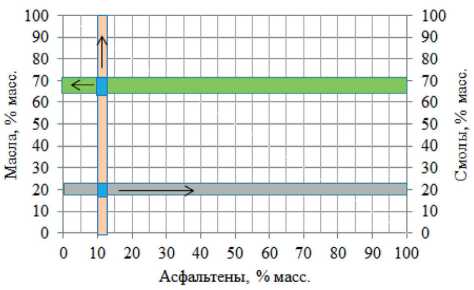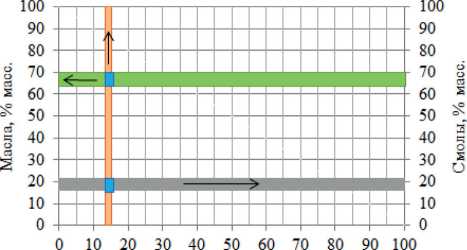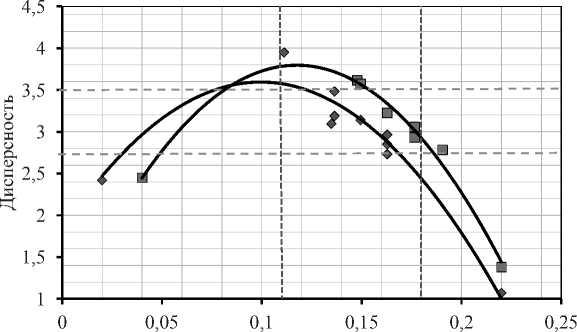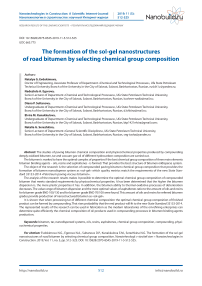The formation of the sol-gel nanostructures of road bitumen by selecting chemical group composition
Автор: Evdokimova N.G., Egorova N.A., Sultanova D.P., Kunakkulova E.M., Serezhkina N.G.
Журнал: Nanotechnologies in Construction: A Scientific Internet-Journal @nanobuild-en
Рубрика: Research results of the leading scientists
Статья в выпуске: 5 Vol.11, 2019 года.
Бесплатный доступ
The studies of paving bitumen chemical composition and physicochemical properties produced by compounding deeply oxidized bitumen, tar and vacuum gas-oil of different hydrocarbon composition are carried out. The bitumen is marked to have the optimal complex of properties if the best chemical group composition of three main elements bitumen binding agents – oils, resins and asphaltenes - is formed. That provides the best structure of bitumen oildisperse system. The object of the research is the selection of compounded paving bitumen chemical group composition that provides the formation of bitumen nanodisperse system as «sol-gel» which quality metrics match the requirements of the new State Standard 33133-2014 «Petroleum paving viscous bitumen». The analysis of the research results makes it possible to determine the optimal chemical group composition of compounded bitumen that meets standard requirements by physicochemical properties. It has been determined that the higher the bitumen dispersion is, the more plastic properties it has. In addition, the bitumen ability to thermal-oxidative processes of deterioration decreases. The value range of bitumen dispersion and the most optimal values of asphaltenes ratio to the amount of oils and resins for bitumen grade BND 100/130 and for bitumen grade BND 70/100 were found. This amount of oils and resins for referred bitumen grades provide production of nanostructured bitumen as «sol-gel». It is shown that when processing tar of different chemical composition the optimal chemical group composition of finished product can be formed by compounding. That rises probability that the end product will fit to the new State Standard 33133-2014. The represented results of the research can be used in fabrication as the modern laboratories of the oil-refining enterprises can determine quite efficiently the chemical composition of oil products used in compounding processes in bitumen binding agents production.
Bitumen, tar, nanodispersed systems, oils, resins, asphaltenes, chemical group composition, compounding, physicochemical properties
Короткий адрес: https://sciup.org/142227458
IDR: 142227458 | УДК: 665.775 | DOI: 10.15828/2075-8545-2019-11-5-512-525
Текст научной статьи The formation of the sol-gel nanostructures of road bitumen by selecting chemical group composition
The formation of the sol-gel nanostructures of road bitumen by selecting chemical group composition by Evdokimova N.G., Egorova N.A., Sultanova D.P., Kunakkulova E.M., Serezhkina N.G. is licensed under a Creative Commons Attribution 4.0 International License.
Based on a work at .
Permissions beyond the scope of this license may be available at .
The formation of the sol-gel nanostructures of road bitumen by selecting chemical group composition by Evdokimova N.G., Egorova N.A., Sultanova D.P., Kunakkulova E.M., Serezhkina N.G. is licensed under a Creative Commons Attribution 4.0 International License.
Based on a work at .
Permissions beyond the scope of this license may be available at .
П рименение высококачественных нефтяных битумов обеспечивает долговечность асфальтобетонных покрытий в условиях интенсивного движения автотранспорта. Качество битумов как нефтяных дисперсных систем непосредственно связано с их структурой и свойствами, которые определяются количественным соотношением масел, смол и асфальтенов [1–9]. Эти три основных структурных элемента битумных вяжущих взаимодействуют между собой и образуют ту или иную разновидность микрогетерогенной нанодисперсной структуры [10–13].
Одним из перспективных и эффективных методов получения нефтяных битумов является технология, основанная на смешении глубокоокисленного битума с тяжелыми нефтяными остатками (гудронами) – «окисление-компаундирование» [14–17]. Данная технология внедрена на некоторых российских предприятиях. Она позволяет расширить ассортимент выпускаемой продукции и улучшить свойства нефтяных битумов. В результате подбора оптимального соотношения компаундов можно достичь наилучшего группового химического состава битума и его
дисперсности [18–21] и получить готовую битумную продукцию, соответствующую ГОСТ 33133-2014.
Битумы будут обладать оптимальным комплексом свойств только в том случае, когда они имеют наилучший групповой химический состав из масел, смол и асфальтенов и сформирована определенная структура нефтяной дисперсной системы. Исследования процессов структурообразования битумов позволяют выявить возможные дисперсные структуры, образующиеся в битуме в зависимости от количества и природы асфальтенов, вида углеводородов и количества смол в дисперсионной среде.
Результаты, представленные в работе [22], свидетельствуют о зависимости эксплуатационных свойств битумов от их химического состава, который характеризуется величинами отношения содержания асфальтенов к содержанию смол (А/С) и суммой асфальтенов и смол к содержанию масел (А+С)/М. Установлено, что битумы тепло- и морозостойкие с высокой прочностью должны содержать 23% масс. смол, 15–18% масс. асфальтенов, 52–54% масс. масел и иметь соотношения А/С = 0,5–0,6 и (А+С)/М = 0,8–0,9.
Колбановская А.С. [19, 23, 24] предложила свою систему классификации битумов, связав характер
Таблица 1
Показатели качества гудронов и глубокоокисленных битумов
|
Наименование показателей |
Наименование сырья |
|||
|
Гудрон I |
Битум I |
Гудрон II |
Битум II |
|
|
Условная вязкость при 80оС, сек. |
96 |
– |
87 |
– |
|
Изменение температуры размягчения после старения, оС |
4 |
8 |
4 |
8 |
|
Плотность при 15оС, кг/м3 |
1001 |
– |
1007 |
– |
|
Температуры вспышки в открытом тигле, оС |
341 |
– |
332 |
– |
|
Температура размягчения по КиШ, оС |
34 |
81 |
32 |
64 |
|
Глубина проникания иглы при 25оС, 0,1 мм |
– |
42 |
– |
38 |
RESEARCH RESULTS OF THE LEADING SCIENTISTS • РЕЗУЛЬТАТЫ ИССЛЕДОВАНИЙ ВЕДУЩИХ УЧЕНЫХ этом отношение асфальтенов к общей сумме асфальто-смолистых веществ (А/(С+А)) должно быть 0,39–0,44, а отношение асфальтенов к сумме масел и смол (А/(М+С)) – 0,25–0,30.
Однако в процессы переработки вовлекается нефть новых месторождений или ее смеси. Природа и структура асфальтенов, смол и виды углеводородов этой нефти отличны от тех, которая перерабатывалась ранее, и будут оказывать существенное влияние на свойства как сырья битумного производства, так и самих битумов. Поэтому исследования, направленные на изучение и определение химического состава современных битумов, являются необходимыми, т.к. полученные результаты позволят сформировать качественное наноструктурированное битумное вяжущее оптимальной структуры для долговечных асфальтобетонных дорожных покрытий.
Целью исследований стал подбор наилучшего группового углеводородного состава компаундированных
дорожных битумов, который обеспечит образование нанодисперсной структуры битума типа «золь-гель», показатели качества которого обеспечат требования нового стандарта ГОСТ 33133-2014 «Битумы нефтяные дорожные вязкие».
Объекты исследований. В качестве объектов исследований были использованы гудроны (гудрон I, гудрон II), глубокоокисленные битумы (битум I, битум II), полученные их этих гудронов, и вакуумный газойль (ВГ) установки первичной переработки нефти. Основные показатели качества используемых веществ показаны в табл. 1 и 2.
Групповой углеводородный состав определяли на лабораторной установке «Градиент-М» с детектором по теплопроводности методом жидкостно-адсорбционной хроматографии с градиентным вытеснением. Данная методика позволяет с наименьшей погрешностью определить групповой состав тяжелых нефтепродуктов с разделением на семь групп: пара-
Таблица 3
Групповой углеводородный состав объектов исследования
|
Наименование групповых соединений |
Содержание, % масс. |
||||
|
Гудрон I |
Гудрон II |
Битум I |
Битум II |
Вакуумный газойль |
|
|
Парафино-нафтеновые углеводороды |
26,8 |
24,8 |
29,8 |
23,8 |
73,6 |
|
Легкие ароматические углеводороды |
13,7 |
15,6 |
9,0 |
10,1 |
8,6 |
|
Средние ароматические углеводороды |
1,0 |
1,8 |
1,7 |
2,4 |
1,7 |
|
Тяжелые ароматические углеводороды |
36,2 |
33,3 |
21,0 |
21,4 |
12,0 |
|
Сумма масел |
77,7 |
75,5 |
61,5 |
57,7 |
95,9 |
|
Смолы |
19,9 |
20,3 |
20,0 |
24,0 |
2,6 |
|
Asphaltenes |
2,4 |
4,2 |
18,5 |
18,3 |
1,5 |
Таблица 4
Состав и групповой химический состав образцов битумов, полученных на основе сырья I и вакуумного газойля
|
№ образца |
Содержание компонентов, % |
Содержание, % |
||||
|
Битум |
Гудрон |
ВГ |
Масла |
Смолы |
Асфальтены |
|
|
1 |
49 |
46 |
5 |
71 |
19 |
10 |
|
2 |
66 |
24 |
10 |
69 |
18 |
13 |
|
3 |
60 |
25 |
15 |
71 |
17 |
12 |
|
4 |
60 |
20 |
20 |
72 |
17 |
12 |
|
5 |
60 |
35 |
5 |
69 |
19 |
12 |
|
6 |
73 |
17 |
10 |
68 |
18 |
14 |
|
7 |
70 |
15 |
15 |
69 |
17 |
14 |
|
8 |
75 |
5 |
20 |
69 |
17 |
14 |
RESEARCH RESULTS OF THE LEADING SCIENTISTS • РЕЗУЛЬТАТЫ ИССЛЕДОВАНИЙ ВЕДУЩИХ УЧЕНЫХ фино-нафтеновые углеводороды, легкие, средние, тяжелые ароматические углеводороды, смолы, асфальтены. Групповой углеводородный состав компонентов, применяемых в ходе исследований, представлен в табл. 3.
Результаты исследований
Методом компаундирования были приготовлены образцы битумов с температурами размягчения
45 и 47оС. Состав и групповой химический состав компаундированных битумов, полученных на основе сырья I и II и вакуумного газойля, приведены в табл. 4 и 5, а их физико-химические свойства – в табл. 6 и 7.
Физико-химические свойства полученных образцов битума на основе сырья I и II представлены в табл. 6 и 7.
Анализ результатов исследований позволил установить оптимальный групповой химический состав
Таблица 5
Состав и групповой химический состав образцов битумов, полученных на основе сырья II и вакуумного газойля
|
№ образца |
Содержание компонентов, % |
Содержание, % |
||||
|
Битум |
Гудрон |
ВГ |
Масла |
Смолы |
Асфальтены |
|
|
1 |
60 |
35 |
5 |
66 |
22 |
13 |
|
2 |
68 |
22 |
10 |
65 |
21 |
14 |
|
3 |
85 |
0 |
15 |
63 |
21 |
16 |
|
4 |
65 |
30 |
5 |
65 |
22 |
13 |
|
5 |
75 |
15 |
10 |
64 |
21 |
15 |
|
6 |
82 |
3 |
15 |
64 |
21 |
15 |
Таблица 6
Физико-химические свойства битумов, полученных на основе сырья I и вакуумного газойля
|
Показатель |
№ образца битума |
ГОСТ 33133-2014 |
||||||||
|
1 |
2 |
3 |
4 |
5 |
6 |
7 |
8 |
БНД 100/130 |
БНД 70/100 |
|
|
Температура размягчения, оС |
46 |
45 |
45 |
45 |
47 |
47 |
47 |
47 |
не ниже 45 |
не ниже 47 |
|
Изменение температуры размягчения после старения, оС |
4 |
4 |
7 |
11 |
7 |
11 |
10 |
7 |
не более 7 |
не более 7 |
|
Изменение массы образца после старения, % масс. |
0 |
0 |
0 |
0 |
0,51 |
0 |
0 |
0 |
не более 0,7 |
не более 0,6 |
|
Глубина проникания иглы при 0оС•0,1 мм |
51 |
54 |
56 |
49 |
42 |
49 |
47 |
42 |
30 |
21 |
|
Глубина проникания иглы при 25оС•0,1 мм |
130 |
139 |
140 |
142 |
102 |
93 |
97 |
100 |
101–130 |
71–100 |
|
Растяжимость при 25оС, см |
77 |
48 |
73 |
65 |
45 |
37 |
18 |
62 |
не менее 70 |
не менее 62 |
|
Температура хрупкости, оС |
–25 |
–29 |
–27 |
–28 |
–26 |
–34 |
–30 |
–26 |
не выше –20 |
не выше –18 |
RESEARCH RESULTS OF THE LEADING SCIENTISTS • РЕЗУЛЬТАТЫ ИССЛЕДОВАНИЙ ВЕДУЩИХ УЧЕНЫХ компаундированных битумов, представленный на рис. 1 и 2.
Одной их важных характеристик наноструктури-рованной системы битума является дисперсность, которая характеризует не только размер частиц дисперсной фазы в дисперсной системе, показывает, какое число частиц можно уложить вплотную в одном кубическом метре, но и влияет на физико-химические свойства битумного вяжущего. Чем меньше размер частиц дисперсной фазы битума, который формируется в основном асфальтенами, тем больше его дисперсность [3, 4, 19]. Дисперсность исследуемых битумов определялась по [1]. На рис. 3 показаны
зависимости отношения асфальтенов к сумме масел и смол (А/(М+С)) от дисперсности компаундированных битумов.
Установлено, что чем выше дисперсность битума, тем более пластичными свойствами он обладает, кроме того снижается способность битума к термоокислительным процессам старения. Найден диапазон значений дисперсности битума (2,7–3,5) и наиболее оптимальные значения отношения А/(С+М) для битума марки БНД 100/130 – 0,11…0,15 и для битума марки БНД 70/100 – 0,16…0,18, которые обеспечат получение наноструктурированного битума типа «золь-гель».

Рис. 1. Оптимальный групповой химический состав компаундированных битумов для марки
БНД 100/130

Асфальтены, % масс.
Рис. 2. Оптимальный групповой химический состав компаундированных битумов для марки БНД 70/100
Таблица 7
Физико-химические свойства битумов, полученных на основе сырья II и вакуумного газойля
|
Показатель |
№ образца битума |
ГОСТ 33133-2014 |
||||||
|
1 |
2 |
3 |
4 |
5 |
6 |
БНД 100/130 |
БНД 70/100 |
|
|
Температура размягчения, оС |
46 |
46 |
45 |
47 |
48 |
47 |
не ниже 45 |
не ниже 47 |
|
Изменение температуры размягчения после старения, оС |
6 |
6 |
6 |
5 |
8 |
4 |
не более 7 |
не более 7 |
|
Изменение массы образца после старения, % масс. |
0 |
0 |
0,43 |
0 |
0,43 |
0 |
не более 0,7 |
не более 0,6 |
|
Глубина проникания иглы при 0оС•0,1 мм |
41 |
37 |
54 |
36 |
43 |
44 |
30 |
21 |
|
Глубина проникания иглы при 25оС•0,1 мм |
104 |
110 |
118 |
80 |
82 |
83 |
101–130 |
71–100 |
|
Растяжимость при 25оС, см |
74 |
69 |
58 |
41 |
51 |
76 |
не менее 70 |
не менее 62 |
|
Температура хрупкости, оС |
–27 |
–25 |
–32 |
–28 |
–32 |
–32 |
не выше –20 |
не выше –18 |
Таблица 2
Физико-химические свойства фракции вакуумного газойля
|
Наименование показателей |
Значения |
|
Плотность при 20оС, кг/м3 |
900 |
|
Температура начала перегонки, оС |
180 |
|
До 350оС выкипает, % об |
35 |
|
Температура конца перегонки, оС |
500 |
|
Объемная доля акцизных смол, % |
15 |
|
Температура вспышки, оС |
220 |
пространственной надмолекулярной структуры битумов с содержанием в них основных компонентов и степень взаимодействия между частицами дисперсной фазы битума. Она выделила три типа структур битума: «гель», «золь» и «золь-гель». Структура «золь-гель» является оптимальной структурой для битумов. Применение битумов оптимального структурного золь-гелевого типа обеспечивает увеличение срока службы дорожных покрытий в 1,5–3 раза по сравнению с покрытиями на основе битумов другой структуры [1]. По ее мнению, в битумах должно быть содержание асфальтенов в пределах 21–23% масс., смол – 29–34% масс. и масел – 46–50% масс. При
RESEARCH RESULTS OF THE LEADING SCIENTISTS • РЕЗУЛЬТАТЫ ИССЛЕДОВАНИЙ ВЕДУЩИХ УЧЕНЫХ

Отношение А(М+С) О Сырье 1 □ Сырье 2
Рис. 3. Зависимости отношения асфальтенов к сумме масел и смол (А/(М+С)) от дисперсности компаундированных битумов, полученных на основе сырья I и II и вакуумного газойля
ЗАКЛЮЧЕНИЕ
Таким образом, в битумном производстве методом компаундирования можно сформировать оптимальный групповой химический состав готовой продукции и с большей долей вероятности получить продукцию, соответствующую новому стандарту ГОСТ 33133-2014.
Современная лабораторная база нефтеперерабатывающих предприятий позволяет достаточно оперативно определять химический состав нефтепродуктов, поэтому результаты, представленные в работе, могут быть квалифицированно использованы в производстве.
Список литературы The formation of the sol-gel nanostructures of road bitumen by selecting chemical group composition
- Gong R.B. Oil bitumen. Moscow: Chemistry, 1973. 432 p. (In Russian).
- Rebinder P.A. Surface phenomena in disperse systems. Moscow: Science, 1978. 294 p. (In Russian).
- Safieva R.Z. Physical chemistry of oil. Physical and chemical basis of oil refining technology. Moscow: Chemistry, 1998. 448 p. (In Russian).
- Syunyaev Z.I., Safieva R.Z., Syunyaev R.I. Oil disperse systems. Moscow: Chemistry, 1990. 226 p. (In Russian).
- Rudenskaya I.M., Rudensky, A.V. Organic binding agents for road construction. Moscow: Infra-M, 2010. 267 p. (In Russian).
- Fryazinov V.V. Investigation of influence of hydrocarbon component on properties of bitumen: dis. cand. sc. eng.: 05.17.07. Ufa, 1975. 216 p. (In Russian).
- Apostolov S.A. Scientific basis for the production of bitumen. Leningrad: Publishing house of LSU, 1988. 165 p. (In Russian).
- Akhmetov B.R., Evdokimov I.N., Eliseev N.Yu. Some features of supramolecular structures in oil environment. Chemistry and technology of fuels and oils. 2002. No. 4. Pp. 41–43. (In Russian).
- Belokon N.Yu. Kompaneets V.G., Kolpakov I.V. Investigation of the tar group composition influence on the quality of industrial oxidized bitumen. Refining and petrochemistry. 2001. No. 1. P. 19–23. (In Russian).
- Rudenskaya I.M., Rudensky A.V. Organic binding agents for road construction. Moscow: Infra-M, 2010. 267 p. (In Russian).
- Unger F.G., Andreeva L.N. Fundamental aspects of petroleum chemistry. Nature of resins and asphaltenes. Novosibirsk: Nauka Publ. 1995. 192 p. (In Russian).
- Nelyubova V.V., Kobzev V.A., Sivalneva M.N., Podgornyj I.I., Palshina Yu.V. Peculiarities of nanostructured binding agents depending on the genesis of raw material. Vestnik BGTU im. V.G. Shuhova. 2015. No.2. Pp. 25–28. (In Russian).
- Gotovtsev V.M., Shatunov A.G., Rumyantsev A.N., Sukhov V.D. Nanotechnologies in the production of asphalt concrete. Fundamental studies. 2013. No. 11. Pp. 191–195. (In Russian).
- Evdokimova N.G., Khartanovich K.V., Zhirnov B.S., Khannanov N.R. Receiving paving bitumen by compounding overoxidized bitumen with tar. Electronic scientific journal «Oil and gas business». 2005 No. 1. (14.01.05). http://www.ogbus.ru/authors/ Evdokimova/Evdokimova_1.pdf. (In Russian).
- Evdokimova N.G., Sajfullina A.A., Sharipov A.V. Optimization of the paving bitumen compounding mode at the bitumen installationt of JSC “Salavatnefteorgsintez”. Materials of the III all-Russian scientific and production conference on the production and use of bitumen materials. Perm: LUKOIL-Permnefteorgsintez, 2007. Pp. 29–30. (In Russian).
- Evdokimova N.G., Alieva E.A. Production of paving bitumen according to the scheme of “oxidation-compounding” with the usage of a vacuum residue of viscosity breaking installation as a modifier of oxidation raw material. In the collection “Deep processing of oil disperse systems”: materials of VI international scientific-technical conference. Moscow: TUMA GROUP, 2011. Pp. 138–140. (In Russian).
- Kurakulov E.M., Ishkina D.P., Evdokimova N.G. Selection of components for the bitumen production according to the scheme of “oxidation-compounding” on the basis of their chemical composition. Materials of the Intern. science.-method. Conf. “Integration of science and education in oil and gas universities”. Ufa: USPTU. 2018. Pp. 128–131. (In Russian).
- Kurakulov E.M., Ishkina D.P., Evdokimova N.G. Determining the optimal chemical composition of the compounded paving bitumen. Materials of Intern. Theor. and Pract. Conf. dedicated to the 70-th anniversary of Gazprom Neftekhim Salavat. Ufa: USPTU. 2018. Pp. 36–38. (In Russian).
- Evdokimova N.G. Development of the scientific-technological basis of modern bituminous materials production as the petroleum disperse systems. Dr. Sc. Eng. diss.]. Moscow: Russian state University of oil and gas named after I. M. Gubkin, 2015. 410 p. (In Russian).
- Kolbanovskaya A.S. Study of disperse structures in petroleum bitumen in order to obtain optimal material for road construction: abstract of Doctorate thesis. Moscow, 1967. 43 p. (In Russian).
- Efremov A.V. Basyrov M.I., Nikiforov N.N., Evdokimova N.G., Saifullin A.A., Kozlov Yu.M. Study of the compounding process when producing paving bitumen on bitominous installation. Refining and petrochemistry. 2008. No. 4–5, pp. 70–73. (In Russian).
- Erich V.N. Petroleum bitumen. Chemistry and technology of oil and gas. Leningrad: Chemistry, 1985. Pp. 350–355. (In Russian).
- Kolbanovskaya A.S., Mikhailov V.V. Paving bitumen. Moscow: Transport, 1973. 264 p. (In Russian).
- Kolbanovskaya A.S., Davydov, A.R., Sabzi O.Y. Structure formation of paving bitumen. Physicochemical mechanics of disperse structures. Moscow: Science, 1966. Pp. 103–113. (In Russian).


